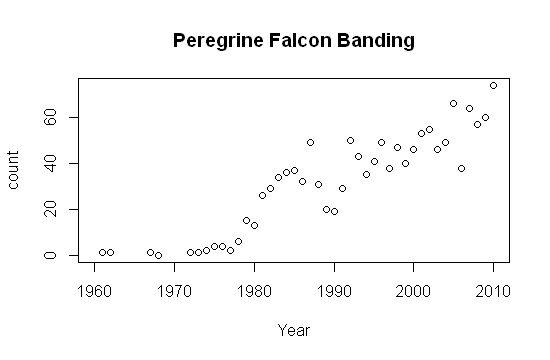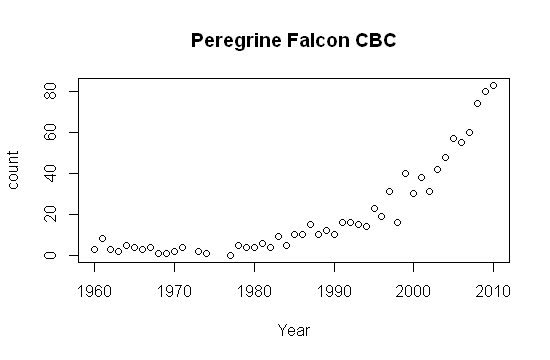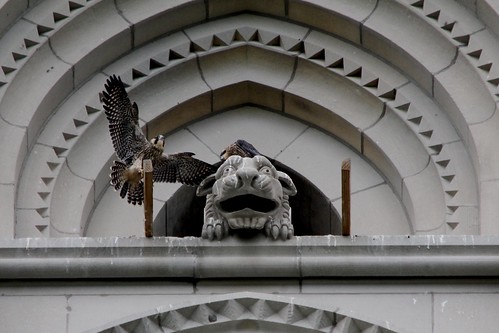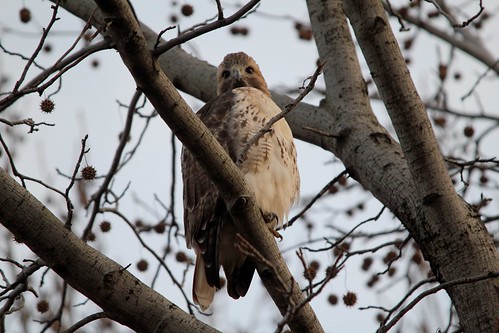This year marks the 50th anniversary of the publication of Silent Spring. In this book, Rachel Carson, described the bleak future that could possibly exist based on the changes to the environment that human activity was causing. Specifically, she warned about the dangers of pest control in the chemical called DDT. She urged the public to consider the consequences of using chemicals like this that were taking a toll on predatory birds, often apex predators in their ecosystems. While DDT is a neurological toxin specific to arthropods (intended to control mosquito populations), the chemical accumulated within the environment and would biomagnify in predatory birds where it was deleterious to various systems and resulted in a thinning of egg shells that caused the destruction of eggs. Apex predators often serve as sentinels for the health of the environment. As peregrine falcon populations became extirpated, the reality of a silent Spring was becoming apparent to the public. 10 years after the publication of her book, the United States government banned the use of DDT.

Banding of Peregrine Falcons in New York State. Hardly any falcons were banded in the 1960’s and 1970’s. After the ban of DDT usage in 1972, successful hatching of Peregrine Falcons and reintroduced Falcons increased the censused population of birds as evidenced by the number of issued bands on an annual basis.

The Christmas Bird Count observations in New York State indicate that there has been an increased rate of spotting wild Peregrine Falcons a decade after the ban of DDT usage in 1972. The increased amount of spotting during the CBC illustrates the enhanced health of the environment through the sentinel species.
The population of Peregrine Falcons has rebounded and they are no longer on the endangered species list. Many often adapt to city dwelling. Below is a picture of nestling falcons readying to fledge at Riverside Church.

Criticizing Silent Spring
Despite the success of the DDT ban and the improved healthiness of local environments, the book often found criticisms. Below is a review of the book from Amazon.com by a user called “Jane Orient”:
DDT was actually good for birds. There is a vast amount of material to refute assertions to the contrary. Bird counts in 1960 (after DDT) vs. 1941 (before DDT) showed 12 times more robins, 21 times more cowbirds, 38 times more blackbirds, 131 times more grackles, etc. Possible protective effects include: increasing plant yields; increasing protective cover; eliminating mosquito-borne bird diseases; and inducing liver enzymes that break down naturally occurring environmental toxins and carcinogens.
Sometimes we see claims that are true in nature that are actually “truthy“. The claim indicates that DDT usage was good for birds and cites some real facts regarding the increased number of birds. While these facts may be real, anyone with a shred of intelligence would point out that they are all prey species and that the decimation of predator species like the Peregrine Falcon resulted in a population explosion. Misleading people with true statements followed by unverifiable statements can often confuse and sway lay people who are not familiar with the argument. By beginning with true facts, the reviewer has augmented the subsequent baseless claims about toxicity. The greatest argument against Silent Spring follows from the same reviewer:
This is one of the most influential books of our time. Even now, it contributes to the death of one child every 12 seconds, mostly in the Third World, because it helped to bring about the ban of DDT with a resulting resurgence of malaria and other insect-borne diseases.
Rachel Carson herself stated:
It is not my contention that chemical insecticides must never be used. I do contend that we have put poisonous and biologically potent chemicals indiscriminately into the hands of persons largely or wholly ignorant of their potentials for harm. We have subjected enormous numbers of people to contact with these poisons, without their consent and often without their knowledge.
Additionally, the DDT ban in 1972 was for the United States. DDT was still manufactured in the U.S. and utilized elsewhere. DDT simply fell out of favor since it was becoming less effective.
Revisiting Silent Spring
As humans, we often have huge impacts on our local environments. The city is a densely populated space and we have created a waste issue. This waste has resulted in the explosion of invasive rodent species. As a consequence, public and private spaces have taken to using anti-coagulant baits instead of addressing waste and sanitation issues. The consequences can be seen below:

Necropsy photos from the New York Department of Environmental Conservation (NYS-DEC) of Lima (red-tailed hawk mate of Pale Male). Within a month of Lima’s death, 4 other hawks in Manhattan were found dead attributable to anti-coagulant rodenticides. One was a motor vehicle accident that probably occurred due to poisoning. This image is taken from a public document by the NY DEC.
The report that accompanied this photo and related hawk deaths in the month of March 2012 indicate that multiple types of anticoagulant rodenticides resulted in spontaneous hemorrhaging or bleeding caused by stress of egg-laying.

Above is a picture of a female red-tailed hawk nesting in Riverside Park. Below is a picture of her from the necropsy report. She died from hemorrhaging following laying an egg.




